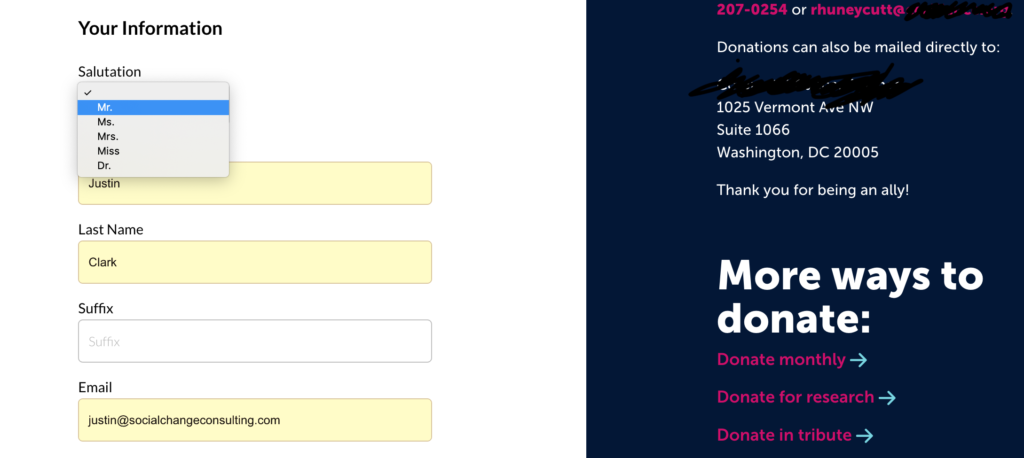This past week has been Transgender Awareness Week, a one-week celebration leading up to Transgender Day of Remembrance/Resilience (TDOR), which memorializes victims of transphobic violence.
We have previously shared suggestions for ways that nonprofits can support Transgender Day of Remembrance/Resilience. Below we outline five additional ways that your nonprofit organization can be more inclusive to transgender, non-binary, and gender-expansive people. If you’re interested in learning more about Transgender Awareness Week or TDOR we recommend these links:
- GLAAD explains more about TDOR and provides links to guides and supporting documents.
- HRC reminds readers of four things to remember during Transgender Awareness Week.
- GLSEN shares a story from Sarah is a member of GLSEN’s Transgender Student Rights Advisory Committee.
These are five changes that nonprofits can make to ensure you are inclusive to all volunteers, donors, and constituents.
Include Inclusive Gender and Sex Term Questions on Forms
You may have forms that ask respondents to answer a question about gender. If this information isn’t necessary, you can remove it. If it is information that you will need, work to ensure that the options you include are inclusive of everyone who may be filling out the form. The ideal way to address this is to leave the form open for people to fill in. If the form is electronic and you don’t have the option to have an open field, we strongly recommend having something in addition to Female, Male, and Other. Only providing “other” can lead to someone thinking that your nonprofit is reinforcing the labeling of “other” as not fitting the societal norm.
If you only have an option of three options, using something like “Non-binary, gender-expansive, or other” may be a sufficient workaround. However, it’s best to consult with your volunteers and staff on finding the options that best fit your community.
For more information on designing forms for gender diversity and inclusion, we recommend this blog post from Sabrina Fonseca and this post on Medium by Sarai Rosenberg.
Add Pronoun to Forms
In early November SCC celebrated a nonprofit partner’s 20th anniversary. We recorded interviews with board members, individuals who had participated in programs, and former staff to celebrate this achievement. The waiver and consent form for recording asked interviewees to write their pronoun. One board member shared their gratitude for this being on the form. Simply including pronoun in a form or including your own when communicating with volunteers helps people know that you’re considerate of their gender identity.
Be Inclusive with Titles
I recently donated to a nonprofit in which title was a mandatory field. My guess is that the organization wanted to send a mailed thank you card that included their donor’s title on the form.

Their selection of titles was not inclusive and was noticeable. A small fix would be to add Mx to a list of titles. It is a gender-neutral title that many individuals use. To understand the small difference this can have, we loved this Instagram post from Mere Abrams.
Gender-Inclusive Bathrooms in Your Office
Do you have a gender-neutral bathroom in your office? If not, you should. There are many ways to do this. This quote from a Teen Vogue article by Danielle Corcione explains why this is critical:
“Many trans and gender nonconforming people have limited access to bathrooms due to the harassment, violence, and threat of arrest they experience in both women’s and men’s bathrooms,” Ethan Lin, director of grassroots fundraising and communications of the Sylvia Rivera Law Project, told Teen Vogue. “Making gender-neutral bathrooms more widely available beyond single stalls ought to be the ultimate goal because being able to use bathrooms without the threat of violence or harassment is a human right, not a privilege.”
Review the Health Insurance You Offer Employees
Reviewing your health insurance options can be beneficial to recruiting and retaining transgender, non-binary, and gender-expansive employees. Check to see if you provide transgender-inclusive insurance coverage and try to remove any health-care exclusions for treatment options like surgery, hormone therapy, or counseling.
Photo Credit: Photo is part of The Gender Spectrum Collection.

Justin (he, him) is a Principal and Co-Founder of Social Change Consulting. He has over fifteen years of nonprofit experience, with expertise in online fundraising, digital communications, and data management. Justin helps organizations connect their communication strategy to their income development needs. When he’s not on the clock, Justin is exploring Berlin, running, listening to too many podcasts, and drinking too much coffee.
